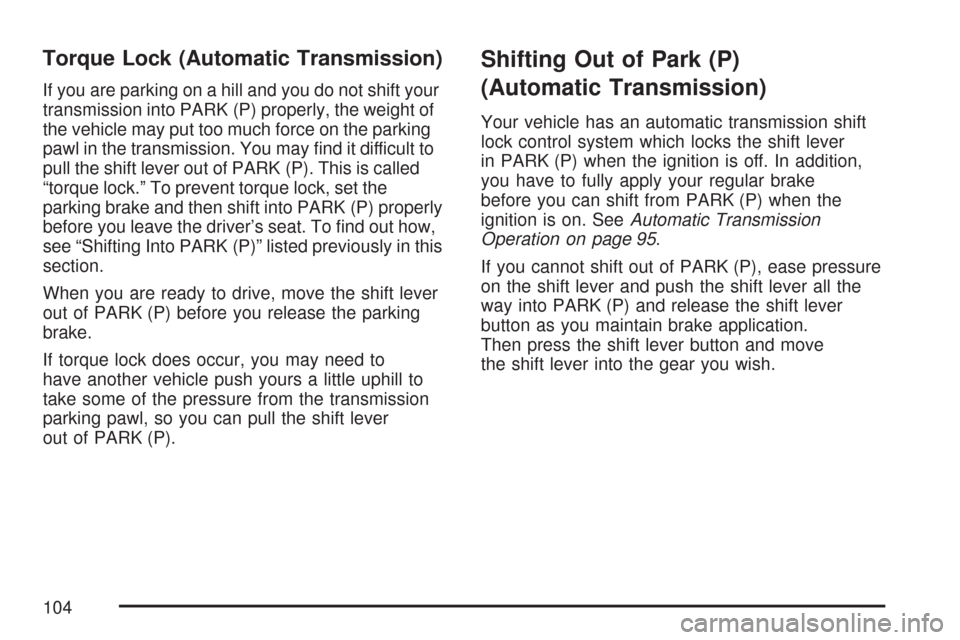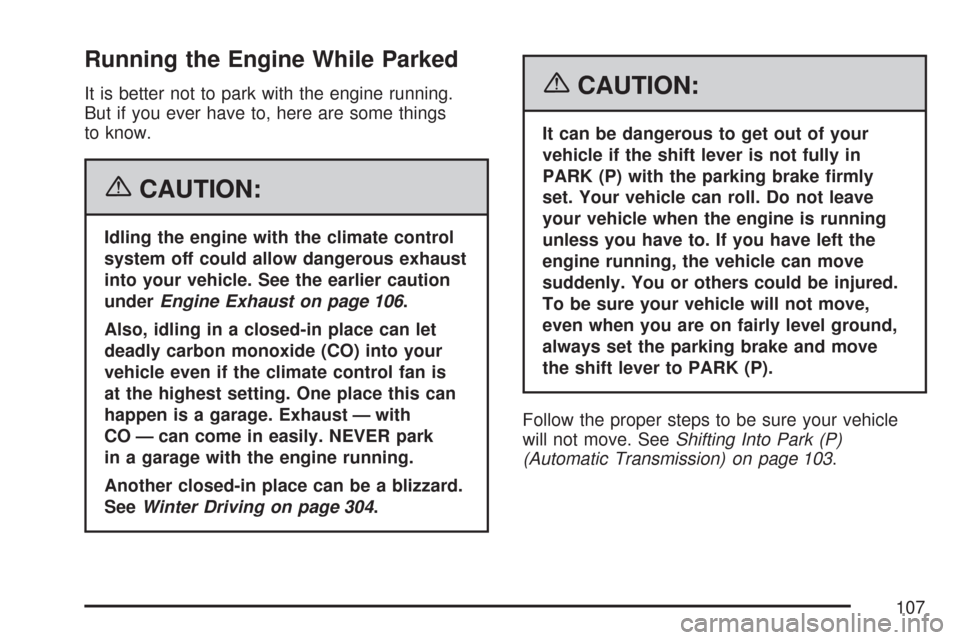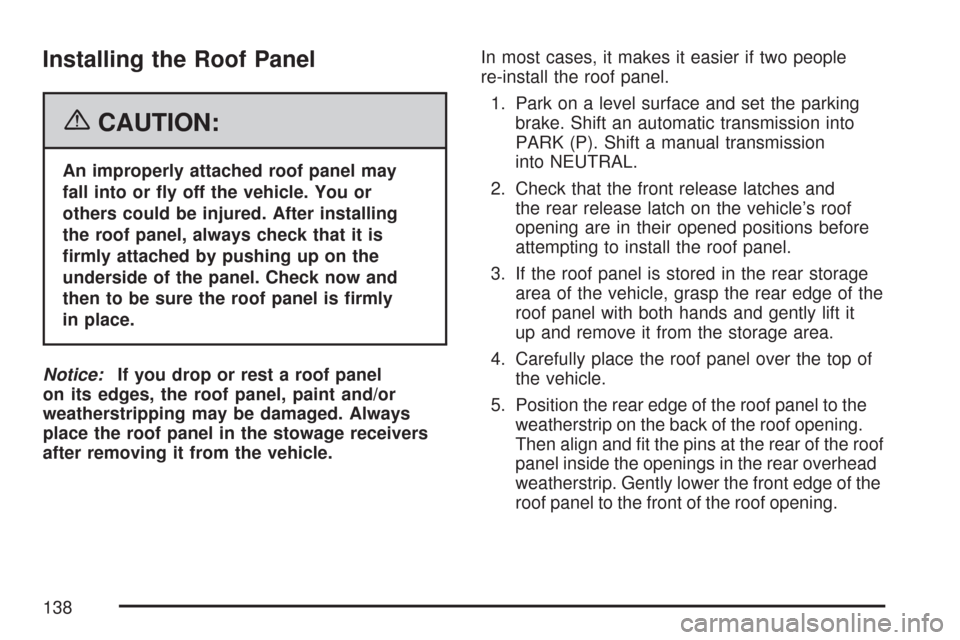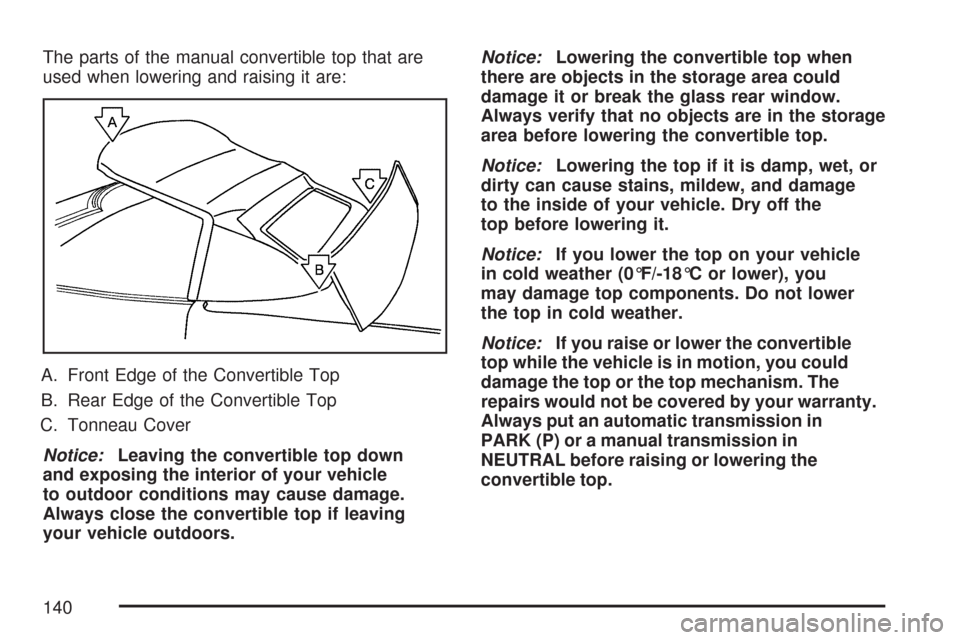Page 104 of 488

Torque Lock (Automatic Transmission)
If you are parking on a hill and you do not shift your
transmission into PARK (P) properly, the weight of
the vehicle may put too much force on the parking
pawl in the transmission. You may �nd it difficult to
pull the shift lever out of PARK (P). This is called
“torque lock.” To prevent torque lock, set the
parking brake and then shift into PARK (P) properly
before you leave the driver’s seat. To �nd out how,
see “Shifting Into PARK (P)” listed previously in this
section.
When you are ready to drive, move the shift lever
out of PARK (P) before you release the parking
brake.
If torque lock does occur, you may need to
have another vehicle push yours a little uphill to
take some of the pressure from the transmission
parking pawl, so you can pull the shift lever
out of PARK (P).
Shifting Out of Park (P)
(Automatic Transmission)
Your vehicle has an automatic transmission shift
lock control system which locks the shift lever
in PARK (P) when the ignition is off. In addition,
you have to fully apply your regular brake
before you can shift from PARK (P) when the
ignition is on. SeeAutomatic Transmission
Operation on page 95.
If you cannot shift out of PARK (P), ease pressure
on the shift lever and push the shift lever all the
way into PARK (P) and release the shift lever
button as you maintain brake application.
Then press the shift lever button and move
the shift lever into the gear you wish.
104
Page 107 of 488

Running the Engine While Parked
It is better not to park with the engine running.
But if you ever have to, here are some things
to know.
{CAUTION:
Idling the engine with the climate control
system off could allow dangerous exhaust
into your vehicle. See the earlier caution
underEngine Exhaust on page 106.
Also, idling in a closed-in place can let
deadly carbon monoxide (CO) into your
vehicle even if the climate control fan is
at the highest setting. One place this can
happen is a garage. Exhaust — with
CO — can come in easily. NEVER park
in a garage with the engine running.
Another closed-in place can be a blizzard.
SeeWinter Driving on page 304.
{CAUTION:
It can be dangerous to get out of your
vehicle if the shift lever is not fully in
PARK (P) with the parking brake �rmly
set. Your vehicle can roll. Do not leave
your vehicle when the engine is running
unless you have to. If you have left the
engine running, the vehicle can move
suddenly. You or others could be injured.
To be sure your vehicle will not move,
even when you are on fairly level ground,
always set the parking brake and move
the shift lever to PARK (P).
Follow the proper steps to be sure your vehicle
will not move. SeeShifting Into Park (P)
(Automatic Transmission) on page 103.
107
Page 134 of 488

Roof Panel
The vehicle may have a removable roof panel.
Follow the procedures listed when removing
or installing it.
Removing the Roof Panel
{CAUTION:
Do not try to remove a roof panel while
the vehicle is moving. Trying to remove
the roof panel while the vehicle is moving
could cause an accident. The panel could
fall into the vehicle and cause you to lose
control, or it could �y off and strike
another vehicle. You or others could be
injured. Remove the roof panel only when
the vehicle is parked.
Until you are sure you can remove the panel
alone, have someone help you.Notice:If you drop or rest a roof panel
on its edges, the roof panel, paint and/or
weatherstripping may be damaged. Always
place the roof panel in the stowage receivers
after removing it from the vehicle.
1. Park on a level surface and set the parking
brake. Shift an automatic transmission into
PARK (P). Shift a manual transmission
into NEUTRAL.
2. Make sure the ignition is off.
3. Lower both sun visors.
4. Open the rear hatch and remove any items
that may interfere with proper storage of the
roof panel.
5. Lower the windows.
There are two release latches on the front of
the roof panel and one rear release latch
on the back of the roof panel.
134
Page 138 of 488

Installing the Roof Panel
{CAUTION:
An improperly attached roof panel may
fall into or �y off the vehicle. You or
others could be injured. After installing
the roof panel, always check that it is
�rmly attached by pushing up on the
underside of the panel. Check now and
then to be sure the roof panel is �rmly
in place.
Notice:If you drop or rest a roof panel
on its edges, the roof panel, paint and/or
weatherstripping may be damaged. Always
place the roof panel in the stowage receivers
after removing it from the vehicle.In most cases, it makes it easier if two people
re-install the roof panel.
1. Park on a level surface and set the parking
brake. Shift an automatic transmission into
PARK (P). Shift a manual transmission
into NEUTRAL.
2. Check that the front release latches and
the rear release latch on the vehicle’s roof
opening are in their opened positions before
attempting to install the roof panel.
3. If the roof panel is stored in the rear storage
area of the vehicle, grasp the rear edge of the
roof panel with both hands and gently lift it
up and remove it from the storage area.
4. Carefully place the roof panel over the top of
the vehicle.
5. Position the rear edge of the roof panel to the
weatherstrip on the back of the roof opening.
Then align and �t the pins at the rear of the roof
panel inside the openings in the rear overhead
weatherstrip. Gently lower the front edge of the
roof panel to the front of the roof opening.
138
Page 140 of 488

The parts of the manual convertible top that are
used when lowering and raising it are:
A. Front Edge of the Convertible Top
B. Rear Edge of the Convertible Top
C. Tonneau Cover
Notice:Leaving the convertible top down
and exposing the interior of your vehicle
to outdoor conditions may cause damage.
Always close the convertible top if leaving
your vehicle outdoors.Notice:Lowering the convertible top when
there are objects in the storage area could
damage it or break the glass rear window.
Always verify that no objects are in the storage
area before lowering the convertible top.
Notice:Lowering the top if it is damp, wet, or
dirty can cause stains, mildew, and damage
to the inside of your vehicle. Dry off the
top before lowering it.
Notice:If you lower the top on your vehicle
in cold weather (0°F/-18°C or lower), you
may damage top components. Do not lower
the top in cold weather.
Notice:If you raise or lower the convertible
top while the vehicle is in motion, you could
damage the top or the top mechanism. The
repairs would not be covered by your warranty.
Always put an automatic transmission in
PARK (P) or a manual transmission in
NEUTRAL before raising or lowering the
convertible top.
140
Page 141 of 488
Lowering the Manual Convertible Top
1. Park on a level surface. Shift an automatic
transmission into PARK (P) and set the
parking brake. Shift a manual transmission
into NEUTRAL and set the parking brake.
2. Make sure the ignition is off.
3. Make sure the trunk is closed.
4. The convertible top front latch, located above
the inside rearview mirror, must be unlocked.
Pull the convertible top front latch down
and turn it clockwise to unlock it.5. Lift upward on the front edge (A) of the
convertible top off of the windshield frame.
Then lift upward on the rear edge (B) of
the convertible top so it is vertical to the
tonneau cover (C). The front edge (A) and
rear edge (B) should be straight up.
141
Page 144 of 488
9. Then move the top rearward to its fully-stored
position.
10. After the top is stored, apply one even push
on the center of the front edge (A) of the
convertible top to assure that the top is fully
retracted.
11. Close the tonneau cover (B) by pressing down
on it with a swift, �rm motion.
Raising the Manual Convertible Top
1. Park on a level surface. Shift an automatic
transmission into PARK (P) and set the
parking brake. Shift a manual transmission
into NEUTRAL and set the parking brake.
2. Lower both windows.
3. Make sure the ignition is off.
4. Tilt the driver’s seat forward and press the
tonneau cover release button, or use the
manual release cable if battery power has been
lost. See Step 6 under “Lowering the Manual
Convertible Top” earlier in this section.
After pressing the release button, the driver’s
and passenger’s door glass should retract
to the full-down position, if they have not
already been lowered.
5. Lift the tonneau cover.
144
Page 147 of 488

Notice:If you lower the top on your vehicle
in cold weather (0°F/-18°C or lower), you
may damage top components. Do not lower
the top in cold weather.
Notice:If you raise or lower the convertible
top while the vehicle is in motion, you could
damage the top or the top mechanism. The
repairs would not be covered by your warranty.
Always put an automatic transmission in
PARK (P) or a manual transmission in
NEUTRAL before raising or lowering the
convertible top.
Lowering the Power Convertible Top
1. Park on a level surface. The vehicle must
be running or in Acc. Shift an automatic
transmission into PARK (P) and set the
parking brake. Shift a manual transmission
into NEUTRAL, and set the parking brake.
2. Make sure the trunk is closed and the rear
trunk partition in the rear storage area is
in the fastened upright position, and that
no objects are forward of the divider.
See “Rear Trunk Partition” underRear
Storage Area on page 131.3. Release the convertible top front latch,
located above the inside rearview mirror,
by pulling and turning it clockwise toward
the driver’s door. Push upward on the front
edge. The windows will automatically lower.
147